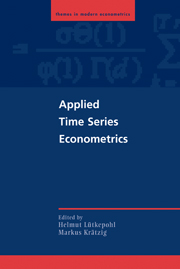Book contents
- Frontmatter
- Contents
- Preface
- Notation and Abbreviations
- List of Contributors
- 1 Initial Tasks and Overview
- 2 Univariate Time Series Analysis
- 3 Vector Autoregressive and Vector Error Correction Models
- 4 Structural Vector Autoregressive Modeling and Impulse Responses
- 5 Conditional Heteroskedasticity
- 6 Smooth Transition Regression Modeling
- 7 Nonparametric Time Series Modeling
- 8 The Software JMu⌉Ti
- References
- Index
1 - Initial Tasks and Overview
Published online by Cambridge University Press: 23 November 2009
- Frontmatter
- Contents
- Preface
- Notation and Abbreviations
- List of Contributors
- 1 Initial Tasks and Overview
- 2 Univariate Time Series Analysis
- 3 Vector Autoregressive and Vector Error Correction Models
- 4 Structural Vector Autoregressive Modeling and Impulse Responses
- 5 Conditional Heteroskedasticity
- 6 Smooth Transition Regression Modeling
- 7 Nonparametric Time Series Modeling
- 8 The Software JMu⌉Ti
- References
- Index
Summary
Introduction
This book discusses tools for the econometric analysis of time series. Generally, a time series is a sequence of values a specific variable has taken on over some period of time. The observations have a natural ordering in time. Usually, when we refer to a series of observations as a time series, we assume some regularity of the observation frequency. For example, one value is available for each year in a period of thirty years, for instance. To be even more specific, consider the annual gross national product (GNP) of some country for a period of 1970 to 1999. Of course, the observation frequency could be more often than yearly. For instance, observations may be available for each quarter, each month, or even each day of a particular period. Nowadays, time series of stock prices or other financial market variables are even available at a much higher frequency such as every few minutes or seconds.
Many economic problems can be analyzed using time series data. For example, many macroeconometric analyses are based on time series data. Forecasting the future economic conditions is one important objective of many analyses. Another important goal is understanding the relations between a set of possibly related variables or uncovering the ongoings within an economic system or a specific market.
Before engaging in an econometric time series analysis it is a good idea to be clear about the objectives of the analysis. They can determine in part which models and statistical tools are suitable. A brief discussion of this initial stage of a project follows in Section 1.2.
- Type
- Chapter
- Information
- Applied Time Series Econometrics , pp. 1 - 7Publisher: Cambridge University PressPrint publication year: 2004

